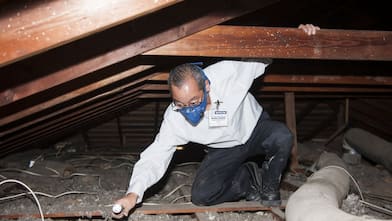Highlights
Clothes moths eat natural fibers and live in bedrooms.
Pantry moths eat food and live in the pantry and/or kitchen.
You can eradicate moths from your house by doing a thorough cleaning.
Prevention requires you to properly store your clothing and food.
There’s nothing nice about finding holes in your favorite sweater, or seeing a clump of flour seemingly move when you re-open the package from your cupboard. Moths are the culprit in either situation. The two common types found in households are the clothes moths and the pantry moths. Once you identify which moth is causing you the drama, then you can confidently move towards getting rid of them once and for all.
What Are Clothes Moths?

There are two different types of clothes moths: the webbing moth (Tineola bisselliell) and the casemaking moth (Tinea pellionella). They are fairly similar to one another, but they differ in the way that they create their cocoons for pupation. And in case you find out that what you’re dealing with isn’t a moth but something else, discover some tips to help you identify winged insects.
Clothes moths are found in your bedroom, they’re very small so they can be hard to spot, and they have a longer life cycle than pantry moths.
What Are Pantry Moths?

Pantry moths, sometimes referred to as Indian meal moths (Plodia interpunctella), got their name because they often live in your pantry. If you’ve seen one flapping around your house, check your cupboards because you may have an infestation.
Infestations are fairly easy to spot because they travel around the home looking for food, and they lay 10 times more eggs than clothes moths.
Clothes Moths vs. Pantry Moths
Clothes moths and pantry moths are both found in your home, but rarely do they live in the same room as one another. They’re both pests that should be taken care of promptly once you confirm an infestation, whether you decide to DIY it or hire a pest control company near you.
Appearance
Clothes moths are 1/2-inch long and are a beige, gray color. Their wings are narrow and hairy. Since they’re so small and avoid light, you’re not as likely to notice a clothes moth.
Pantry moths are 1/3 to 1/5vinches long and have narrow wings that are gray and bronze on the bottom half and yellow-gray on the top. They also have a black stripe on the wings, which makes it easy to identify them. Their wingspan is 5/8 inches.
As larvae, pantry months are an off-white color, 1/2 inches long, and spin silky webs inside containers or bags.
Location
You can find clothes moths in clothing, curtains, upholstery, carpet, and bedding. Some places you may not expect clothes moths include animal bristles in brushes and wool felt pads on pianos. Clothes moths don’t travel around the house, so you’re not likely to see them flying around your home.
Pantry moths usually live in containers or bags of food that are in your pantry. You may also see them flying around in your kitchen. You may also find them behind the fridge and on the top of your cabinets.
Food Sources

Do pantry moths eat clothes? The answer is yes, but it’s not because they like clothes, per se. They eat keratin, which is a protein that is in natural fibers. They eat wool, silk, and cotton, although they will even damage synthetic materials like polyester to get to the natural fibers.
Pantry moths often infect dry foods in your pantry, including:
Oatmeal
Flour
Cereal
Grain
Cornmeal
Rice
Nuts
Pasta
Dried Fruits
Pet Food
Bird Seed
Life Cycle
Clothes moths’ life cycle is 60 days to over 2.5 years. Their eggs hatch in 4 to 10 days, then they are in the larval stage for 35 days to 2.5 years, during which they wreak havoc by eating fibers. They then create a cocoon, and pupation takes 8 to 10 days in the summertime and 3 to 4 weeks in the wintertime. As adults, they live for 30 to 45 days.
The life cycle of pantry moths is 27 to over 300 days. Eggs hatch in 7 to 8 days, although it can take less time depending on the temperature. Larvae live for 6 to 8 weeks, although it can be longer if there is plenty of food available and the weather is suitable. The pupal stage lasts for 15 to 20 days. As adults, they live for 5 to 25 days.
Number of Eggs
Clothes moths lay 40-50 eggs on average, although it can be as many as 100. The pantry moth lays an average of 300 eggs, and as many as 500.
How to Get Rid of Moths
Once you’ve identified a moth infestation in your home, you should start tackling it right away. There are a few approaches you can take to solve your pest problem: cleaning, using products, or hiring an exterminator.
Cleaning
To get rid of clothes moths, you should start by throwing away severely damaged clothing and cleaning the rest. Anything that can be dry cleaned ought to be, especially woolen items. Launder other items in water that’s at least 120 degrees Fahrenheit for 20 to 30 minutes, which kills the larvae in all life stages. Conversely, you can use the cold to kill the moths. They can’t survive if it’s under 18 degrees Fahrenheit or colder.
The moths will also die if you place them in sunlight, so you can take your clothes outdoors on a sunny day and brush them.
To get rid of pantry moths, you have to first start with tackling all of your food items in your cupboards. Check each food item for signs of infestation, and if you find them, throw the entire food item away. Don’t attempt to salvage any of the food, because the larvae infect entire bags and containers of food.
Eventually, you should remove everything from the shelves, throw away the shelf liner paper, and then clean. Use hot, soapy water, and then vacuum every nook and crevice. Once you’re done vacuuming, empty the contents or throw away the filter in a plastic bag and tie it shut. Install new shelf liner paper and start replacing the food.
It’s also a good idea to do a thorough vacuuming job throughout the house, including vacuuming all of the cracks by baseboards.
Products
For clothes moths, you can get pheromone traps. These attract and kill male moths, which can help slow down the infestation. However, the traps don’t kill the eggs and larvae, which are likely the biggest culprits of the damage you’re finding.
Another well-known option is to place mothballs in your dresser. These mothballs release a chemical called 1,4-dichlorobenzen, which suffocates the moths. Just know that mothballs are poisonous to children and pets, not to mention that they can leave a “mothball” smell on your clothing.
For pantry moths, you can buy food-safe traps to place in your cupboards. It’s important that you buy the right kind because regular moth traps can poison your food supply.
Prevention
To prevent a clothes moth infestation, you should store certain clothing in plastic storage bins. These include clothes with wool, fur, or feathers. Store any dresses, suits, or other clothes that hang for a long time in garment bags. If space is an issue, you can buy compression bags for items you’d like to store long-term.
Additionally, there are storage tips for moth-free fresh-smelling clothing like using a dehumidifier, chalk, and activated charcoal.
The best way to prevent a pantry moth problem is to keep your home and kitchen clean. You should also store all food in airtight glass, plastic, or metal containers. It can help to avoid buying food in bulk so you don’t have extra food that’s sitting around for too long. You can also refrigerate any grains that you don’t use often.
DIY vs. Hiring a Pro
With enough work and elbow grease, you can DIY a clothes or pantry moth extermination. However, if you need to call in a pro to make sure the job is thoroughly done, that can be a good option too. Professional moth extermination costs between $100 to $200 depending on the severity of the infestation, accessibility, and treatment method.
Even if you choose to have a professional exterminator get rid of your moth problem, it’ll still be up to you to take the proper preventative steps so your house is no longer friendly to moths.





